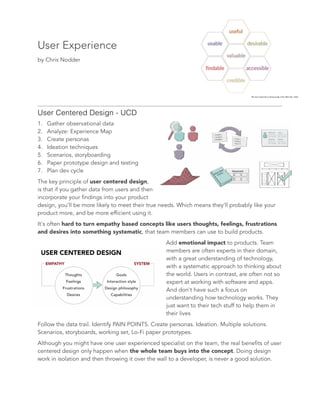The document provides an overview of the user experience design process, beginning with gathering observational data through site visits and analyzing it to create experience maps and personas. It then discusses techniques for idea generation like scenarios and storyboarding, as well as paper prototyping and testing. The whole team should be involved from the beginning in order to truly incorporate user needs. Observational research is emphasized as the foundation for an empathy-driven and user-centered approach.









![• Working software over Comprehensive documentation
• Customer collaboration over Contract negotiation
• Responding to change over Following a plan
• That is, while there is value in the items on the right, we
value the items on the left more.[1]
CHECK OUT: Star UML http://staruml.io/
!
IDENTIFY OBJECTS in the applications. Take use cases
and highlight all the NOUNS.
Primary message, is it getting through? Find out: http://clueapp.com/](https://image.slidesharecdn.com/75b4806a-3699-4867-be22-a8a7b13bc128-151107175229-lva1-app6891/85/UX-10-320.jpg)
![http://clueapp.com/about CLUE is the BOMB
!
TEST DRIVEN DEVELOPMENT - TDD
Automated testing as a part of dev. OOP. Unit Testing.
Testing our code. Test as we write. Automated unit
testing.
Normally, write logic, then test. That may be unit
testing. But TDD asks us to write the test FIRST. Write
test first, which fails, then the least amount logic to pass the test.
Incremental test, try to pass, test, try to pass… Very common in Java, not so much in Objective-
C. Eclipse has testing. Assert.
This fits very nicely with AngularJS. TDD tools Karma for Unit Testing, Protractor E2E.
COOL SOFTWARE
MVC framework AngularJS sees itself as adding meaning to HTML. I think the implication is in
common use, HTML is too stripped down. Yes, you can see the structure, but you cannot see
the meaning.
Moreover, the role of JavaScript has become more to manipulate the DOM than provide
interactivity. This cannot be a good thing; why build your house on one side of the street and
then move it to the other side?
According to Wikipedia, “AngularJS is built around the belief that declarative programming
should be used for building user interfaces and wiring software components, while imperative
programming is excellent for expressing business logic.[1] “
If you have seen ng-apps, they contain considerably less code. The HTML is more readable and
and the JavaScript is focused on interactivity. Plus, as I mentioned Angular lends itself to TDD
with Karma and Protractor
Ruby on Rails as far as I can tell, as I have only so far been dabbling, exemplifies OOP par
excellance. Dynamic Ruby is interpreted. Clean undertandable code (not bad for a C-based
kind of guy). Rails framework is DRY, emphasizing Convention over Configuration. Perfect.
PHP by contrast is, quite frankly an ubiquitous mess of spaghetti code. Java is a bit verbose
and “run once, compile twice”? Yeesh. Ruby on Rails plays nice with AngularJS and is happy to
accomodate all orders of custom data structures (graphs? document store?) and collections.
RESOURCES
CHECK OUT: Star UML http://staruml.io/
http://designcomics.org/ the BOMB. from Sun Microsystems and Cisco
http://clueapp.com/about CLUE is the BOMB](https://image.slidesharecdn.com/75b4806a-3699-4867-be22-a8a7b13bc128-151107175229-lva1-app6891/85/UX-11-320.jpg)